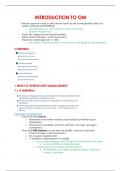INTRODUCTION TO OM
- Reader daarvan moet je alles kennen heeft hij zelf samengesteld (alles is te
weten, OOK DE VOETNOTEN!!!)
o Zelf gemaakt, dus als je dat kent is dat voldoende
o Slides en reader dus
- Goed zijn vragen kunnen beantwoorden
- Geen samenvattingen, want nieuwe prof
- Theorie en oefeningen elk +/- 50%
o Niet grafisch rekenmachine & formularium mag (gaat hij nog opstellen)
CONTENTS
1 WHAT IS OPERATIONS MANAGEMENT
1.1 A definition
Operations management
- Gaat over een proces
o Nadenken over welke manier je als bedrijf je activiteiten gaat
organiseren
o Hoe proces voorstellen, eruit ziet, plannen, manage, opvolgen,
controleren,…
- Voor de CORE business (wat je doet als bedrijf, waarom je bestaat)
o Product maken of service leveren
o Dit zo goed mogelijk doen
o = operations (departement in bedrijf)
▪ Op de vloer bezig zijn met te doen wat het bedrijf moet doen
• Bv product/dienst maken/leveren
▪ Ondersteunt door andere departementen
• Bv financiën: opvolgen winstgevendheid, marketing:
product verkopen
, - Nodigheden
o Resources: grondstoffen, arbeid, kapitaal, informatie, klanten, markt
(INPUT)
▪ Zodat je de klant iets goed kan leveren (dienst of product)
Waar speelt het een belangrijke rol
- Alle 4 gebruiken het!
- Loodgieter: zo goed mogelijk plannen & organiseren
o Boekhouding, juist werkgrief meenemen anders ben je niet efficient
o ‘hoe organiseer ik mezelf om een goed of dienst aan te bieden aan de
klant (want dat is zijn core business)’
o 20x heen en weer rijden voor materialen kost onnodig geld en is niet
efficiënt
Belang
- All organizations rely on OM & primarily support operations function
o w/o operations = no goods/services
1.2 The history of operations management
1.2.1 Industrial revolution
Begin
- Goods produced in small shops by craftsman
o 1 person responsible for making a complete product
o Only simple tools
- Shortcomings:
o Slow & costly
o Production cost not decrease when volume increases
▪ No economies of scale
▪ => companies don’t expand, small companies emerged
New innovations
- Substituting machine power for human power
o Steam engine + standard gauging system
- Rapid growth, more jobs
- BUT: management theory & practice didn’t progressed
,1.2.2 Scientific management
Changes to the management of factories
- Started by Taylor & he believed:
o The science of management
▪ Based on observation, measurement, analysis, improvement of
work methods & economic incentives
o Management: responsible for planning, selecting & training workers,
finding best way to perform job , achieving cooperation btw
management & workers
- Goal: maximizing output
o Not popular with workers
▪ Increase output w/o increase in compensation
▪ Abuse for efficiency
o Public to halls of Congress
Henry Ford used Taylor’s method
- 20th century: automobiles hard to follow the orders
- Moving assembly line: improve efficiency & production
o Introduction of mass production of the automotive industry
▪ = large volumes of standardize goods produced by semi-skilled
workers using costly equipment
o Key concept: interchangeable parts
▪ Standardize parts so it would fit any automobile
• Not customized, used for replacements
▪ Result: decrease in assembly time & cost
- Division of labour
o = an operation divided into series of small tasks for individual workers
▪ No skill required
- RESULT: increase production rate using inexpensive labour
o Also despised by workers => low regard & must perform like robots
o Start of the human relations movement
1.2.3 The human relations movement
Importance of human element in job design
- In addition to the physical & technical aspects of work: worker motivation is
critical for improving productivity
o Shown by many studies
1.2.4 Decision models and management science
Factory movement accompanied by quentitatieve techniques
- First not widely used
- W0II changed that
o Pressure on manufacturing output & specialist worked together
o After war: models for forecasting, inventory management…
- 1960s: management science techniques highly regarded, but lost favour
o BUT: widespread of personal computers & software in workplace
resurgence the popularity
, Japan
- Refined/developed management practices to increase productivity & quality
o Very competitive + got interest from other companies
- Influence of Japan
o Quality, worker teams & customer satisfaction
o = quality revolution + interest in lean production
1.4 Good versus service/ Manufacturing vs service organizations
2 kinds of organizations: manufacture & provide service
- Difference not mutually exclusive
o Overlap btw the 2
▪ Manufactures offer service as part of their operations
▪ Service firms provide or use during service physical goods
o All organizations are some kind of blend of both extremes
Good: kan je vasthouden &geven aan iem
- Voordelen: je kan die opslaan als die niet meteen verkocht w
- Niet veel directe interactie met de klant (snel overbrengen aan klant)
- Klant wordt de eigenaar (duidelijke ownership over bv tas)
Service: niet vasthouden
- Bv reparatie wagen, loodgieter, docent
- Je krijgt die, maar niet fysiek geven
- Je kan die niet opslaan
Voorbeelden
- Gaan eten op restaurant
o Service & product
o Entertainment ober, geluid, lichten & delen dat je krijgt is product
(eten)
- Maatpak laten maken
o Je wilt een fysiek product, maar je hebt ook een dienst nodig (= grote
interactie tussen jouw en de verkoper)
o Pak kan je opslaan, maar dienst niet




